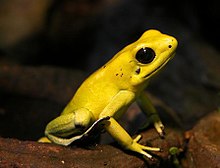
Back فيلوباتس ARZ Листолази Bulgarian Phyllobates Catalan Phyllobates CEB Blattsteiger German Filobatoj Esperanto Phyllobates Spanish Phyllobates Basque قورباغههای زهرآگین طلایی Persian Phyllobates Finnish
| Phyllobates | |
|---|---|

| |
| P. terribilis | |
| Scientific classification | |
| Domain: | Eukaryota |
| Kingdom: | Animalia |
| Phylum: | Chordata |
| Class: | Amphibia |
| Order: | Anura |
| Family: | Dendrobatidae |
| Subfamily: | Dendrobatinae |
| Genus: | Phyllobates Duméril and Bibron, 1841 |
| Species | |
|
6, see text | |
Phyllobates is a genus of poison dart frogs native to Central and South America, from Nicaragua to Colombia. There are 3 different Colombian species of Phyllobates, considered highly toxic species due to the poison they contain in the wild.
Phyllobates contains the most poisonous species of frog, the golden poison frog (P. terribilis). They are typical of the poison dart frogs, in that all species have bright warning coloration (aposematism), and have varying degrees of toxicity. Only species of Phyllobates are used by natives of South American tribes as sources of poison for their hunting darts. The most toxic of the many poisonous alkaloids these frogs contain (in glands in their skin) is batrachotoxin, alongside a wide variety of other toxic compounds. Some populations of Phyllobates lugubris in Central America are not known to be toxic.[1]
- ^ Daly, J.W. (1995). The chemistry of poisons in amphibian skin. Proceedings of the National Academy of Sciences 92: 9-13.
© MMXXIII Rich X Search. We shall prevail. All rights reserved. Rich X Search